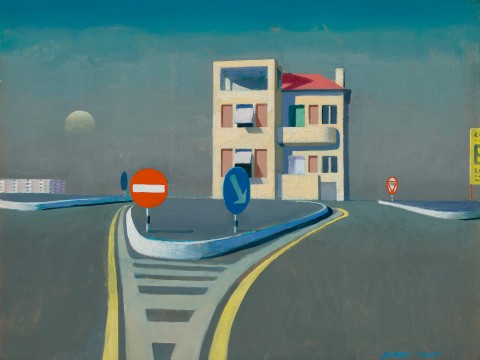SECOND STUDY FOR HOUSE AT INTERSECTION, 1977
JEFFREY SMART
oil on canvas on composition board
27.5 x 37.5 cm
signed lower right: JEFFREY SMART
Australian Galleries, Melbourne (label attached verso)
John Sleigh, Victoria
Savill Galleries, Sydney (label attached verso)
Private collection, Sydney
Jeffrey Smart, Australian Galleries, Melbourne, 29 March – 11 April 1978, cat. 19
On loan to Benalla Art Gallery, Victoria, 1984 – 1990 (exhibited December 1989 – January 1990)
Quartermaine, P., Jeffrey Smart, Gryphon Books, Melbourne, 1983, cat. 708, p. 115
McDonald, J., Jeffrey Smart / Paintings of the ’70s and ’80s, Craftsman House, Sydney, 1990, cat. 149, p. 158
House at Intersection, 1977, oil on canvas, 53.0 x 60.0 cm, private collection, illus. McCulloch, A., ‘The Fantin of the Autostrada’, Melbourne Herald, Melbourne, 6 April 1978
We are grateful to Stephen Rogers, Archivist for the Estate of Jeffrey Smart, for his assistance with this catalogue entry.
Few paintings better exemplify Jeffrey Smart’s pictorial intelligence and wit than this image of a pristine traffic intersection before a double-storey modern townhouse. There is no mistaking we are in Italy, on the outskirts of a town or city, and it is late afternoon on an idyllic summer’s day. The artist even alludes to a theme used by painters who evoked the melancholy Italian verse of the poet Shelley: this is a moonrise picture.1
Smart had been settled near Arezzo for seven years when he produced this painting. Familiarity with the area saw him directing attention upon otherwise unremarkable motifs passed daily in his car: traffic signs, bus stops, overpasses, apartment blocks. For him they represented a sort of mute theatrical cast, objects he might deploy in different combinations across pictures. The creative challenge in working this way was to develop a striking design, hitting upon a visual drama that might serve as a source of endless fascination.
The solitary townhouse in this study is an invention. There was no small building precariously sited on a traffic island. Instead the artist devised it from architectural drawings in his sketch books, then finished his paint with an orange hue and shadows to convey illumination from a setting summer sun. The accompanying road markings—which feature in several 1970s paintings—are adapted from the Arezzo turnoff on the A1 motorway from Rome to Florence. The artist used variants of this configuration to display his mastery of geometry, always having one edge curve gracefully upward. Optically he also used turnoff markings to lead the viewer’s eye through the centre of his compositions, while also stabilising an overall design. The remaining elements in this study are five signs and a very distant building. Smart positions them evenly along his horizon line, using colour and size to highlight the ‘No Entry’ traffic sign on the left of centre. With it Smart uses the white bar against red to echo the horizon behind, while he has the sign’s circular shape also rhyme visually with the adjacent ascending moon, an identically sized blue disc in the serene sky.
The artist graded this particular work as a ‘second’ study. Smart’s initial studies—some of them pencil drawings, others small oil sketches—will employ one or more motifs he intended to use in a picture. But they can show him grasping for a definitive composition. Props are still being moved around his stage, the backdrop is undecided, lighting is yet to be confirmed. Then comes Smart’s so-called ‘second’ study. Technically it might be more than the second variant on a theme, but this tasty piece sees him cement the picture’s design. It amounts to the dress rehearsal. Objects are placed and posed like actors with, apart from a few details, the visual elements seen in their final settings. So, as visual summations of a major composition, his ‘second’ studies are hardly to be classed as lesser pictures. Indeed, as this Second Study for House at Intersection, 1977 shows, certain studies by Jeffrey Smart amount to minor masterpieces.
1. Smart would quote snatches of Shelley’s verse in conversation, sometimes explaining how Italy had inspired particular lines.
DR CHRISTOPHER HEATHCOTE
